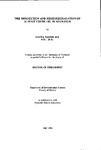THE DISSOLUTION AND PHOTODEGRADATION OF KUWAIT CRUDE OIL IN SEAWATER
| dc.contributor.author | ALI, LULWA NASSER | |
| dc.contributor.other | School of Geography, Earth and Environmental Sciences | en_US |
| dc.date.accessioned | 2013-09-17T12:52:33Z | |
| dc.date.available | 2013-09-17T12:52:33Z | |
| dc.date.issued | 1994 | |
| dc.identifier | NOT AVAILABLE | en_US |
| dc.identifier.uri | http://hdl.handle.net/10026.1/1811 | |
| dc.description.abstract |
To further a quantitative understanding of the effects of weathering on oil spilled at sea, a series of laboratory experiments were conducted to investigate the dissolution and photodegradation kinetics of Kuwait crude oil in seawater. A simple and practical method was developed for the preparation of stable homogeneous samples of sea water-soluble oil (SWSF) at 25 "C. The dissolution was monitored by two independent but complementary methods; total dissolved oil was measured by a photochemical dissolved organic carbon (DOC) technique whilst the dominant soluble constituents, aromatic hydrocarbons, were measured by ultraviolet-fluorescence (UVF) spectrophotometry. Maximum dissolution was observed after slowly stirring oil on seawater for 5 days when concentrations were, respectively, 3.2-3.6 fig C mL * seawater (DOC) and 2.4 /xg diesel equivalents mL ' seawater (UVF). C^ntification of the photodegradation of individual SWSF constituents required development and optimisation of a more specific analytical method. The final method involved addition of deuterated internal standards, extraction with n-pentane, controlled evaporation (micro Kudema-Danish concentration) and gas chromatography-mass spectrometry (GC-MS). Particular care was taken to eliminate sample contamination and storage conditions were also optimised. The recovery of deuterated internal standards through the isolation steps ranged from 30% for benzene-d^ to 100% for phenanihrene-diQ. The method allowed more than fifty compounds, mainly low molecular weight aromatic hydrocarbons, to be identified and quantified in the SWSF. Alkylated benzenes ( Q ^ were the most abundant (98% of the dissolved oil) followed by alkylated naphthalenes (C0.3) (= 2%). The oil to seawater partition coefficient of individual hydrocarbons (K^^) showed that hydrocarbons of high aqueous solubility (e.g C0.2 alkylbenzenes) also possessed the lowest partition values, whereas compounds with high partition coefficients (e.g. alkylnaphthalenes) remained mainly in the oil phase. A reproducible method of simulating solar irradiation was established under controlled environmental conditions using a calibrated 1.8 kW xenon lamp. The photodegradation of a model SWSF compound (phenanthrene) followed first-order kinetics (kp= 0.317+0.029) with a half life (tj^J of 2.2 hr at 25 "^C when irradiated at 194 Wm'-. The extrapolation of to latitude 30 *'N (Florida summer sunlight) showed that phenantiirene would degrade in = 9 hr. Some photoproducts including fluorene, fluorenone, 2,2'-diformylbiphenyl, 2,3:4,5-dibenzoxepin, 3,4-benzocoumarin, and 9,10- phenanthrenequinone were identified by GC-MS, although these accounted for only 11% of the initial mass of phenanthrene. UVF and GC-MS methods for examining the photodegradation of phenanthrene were compared. The photochemical fate of the characterised SWSF was investigated using the optimised irradiation system. Benzene and C^s alkylated benzenes showed no evidence of photodegradation after periods of up to 48 hour under the lamp, however, some C4 alkylbenzenes (jec-butylbenzene, 1,2- dimethylbenzene, 1,2,4,5- + 1,2,3,4-tetramethylbenzene and 1,2,3,4-tetrametiiylbenzene) appeared to follow first-order kinetics with respect to irradiation time. The photodegradation rate constants (kp) of the alkylated benzene and alkylated naphthalene isomers were statistically different demonstrating that certain isomers will phoiodegrade faster tiian others under the same conditions. Half lives ranged from 11.8 to 33.6 hr at 25 ''C. The majority of naphthalene (i.e. C^^^) identified in the SWSF of Kuwait crude oil exhibited first-order photodegradation kinetics with differing rate constants. Half lives were: naphtiialene. 15.7 hr; 1-methyl and 2-methyl naphthalene, 14.9 and 12 hr, respectively; l-l-2-ethylnaphthalene, 15.9; 1,6-dimethylnaphthalene, 10.4hr; 1,3,7-and 1,2,4-trimethylnaphthalene, 11.95 and 12 hr, respectively. The low initial concentration of other naphthalene isomers did not allow for accurate photodegradation kinetics to be determined. Extrapolating the data to latitude 30 "N showed that die photodegradation ti;^ expected for tiie determined SWSF compounds were between 4.2 to 7 days. This would make photodegradation an effective weathering process for the removal of spilled oil, particularly in high solar radiation environments. | en_US |
| dc.description.sponsorship | Plymouth Marine Laboratory | en_US |
| dc.language.iso | en | en_US |
| dc.publisher | University of Plymouth | en_US |
| dc.title | THE DISSOLUTION AND PHOTODEGRADATION OF KUWAIT CRUDE OIL IN SEAWATER | en_US |
| dc.type | Thesis | |
| plymouth.version | Full version | en_US |
| dc.identifier.doi | http://dx.doi.org/10.24382/3595 | |
| dc.identifier.doi | http://dx.doi.org/10.24382/3595 |
Files in this item
This item appears in the following Collection(s)
-
01 Research Theses Main Collection
Research Theses Main


